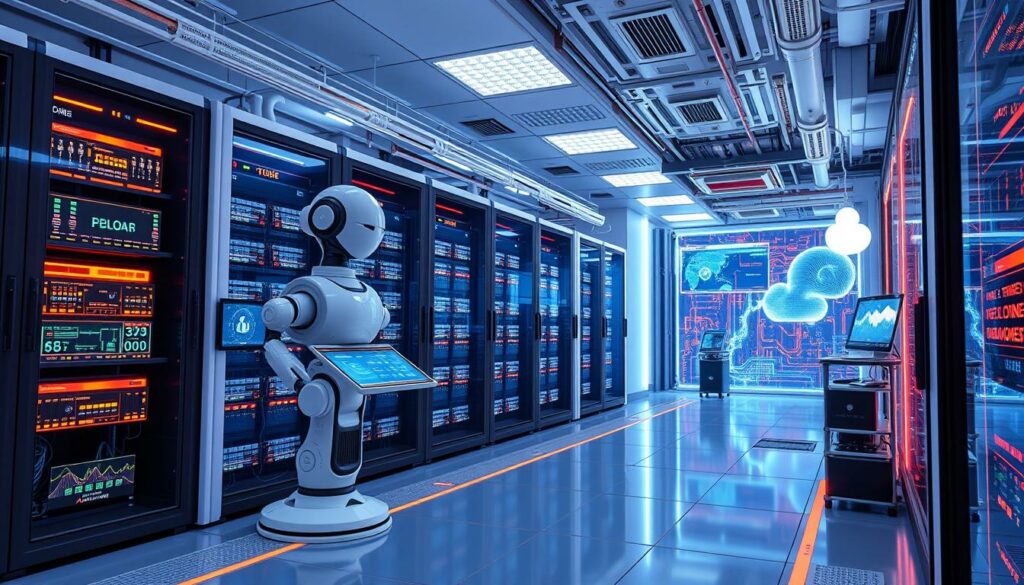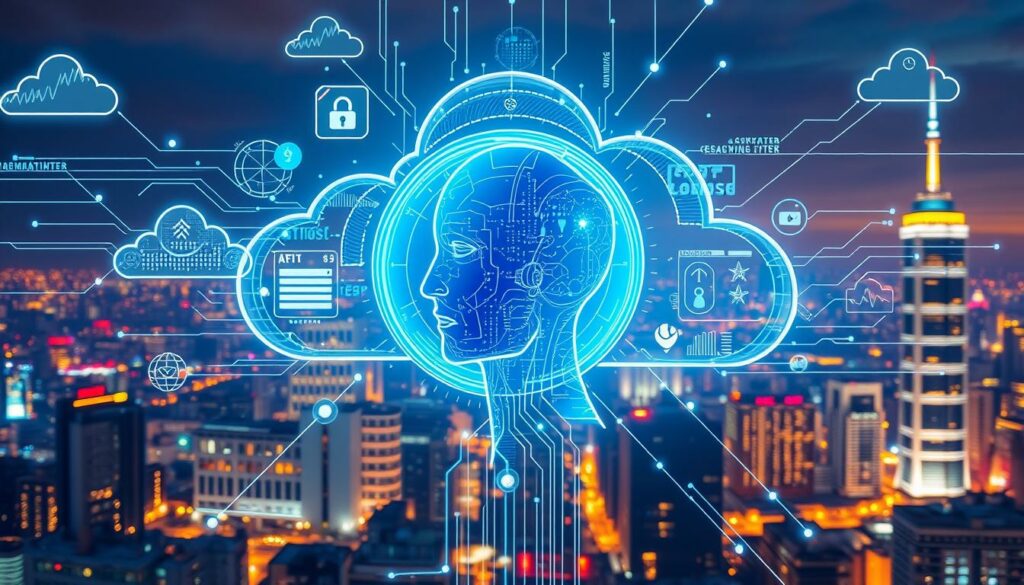The AI agent for cloud computing is now a vital part of IT operations in our rapidly changing tech world. It uses smart automation and machine learning to make cloud operations more efficient. These smart algorithms do tasks automatically, manage resources better, and make security stronger. This helps IT teams deal with complex environments in a forward-thinking way.
AI agents play a big role in making IT workflows smoother, reducing risks, and helping staff focus on new projects. By adding AI to cloud computing, operations run more efficiently. Security gets stronger, and rules and standards are easier to follow.
Key Takeaways
- AIOps platforms predict resource usage for superior performance monitoring.
- Proactive issue estimation helps prevent IT downtime.
- Machine learning models require continuous monitoring and updates.
- AIOps prioritizes alerts based on potential impact to minimize alert fatigue.
- Root cause analysis enhances troubleshooting and incident resolution.
- AI-driven insights accelerate decision-making and automation.
- AI ensures optimal performance through auto-scaling and load balancing.
Introduction to AI Agents in Cloud Computing
AI agents have brought a new level of automation and intelligence to cloud computing. They use artificial intelligence to understand data, foresee what the system needs, and adapt on the go. Their roots go back to the expert systems of the 1970s and 1980s. But those systems couldn’t learn, which held them back.
Thankfully, with reinforcement learning in the 1990s and deep learning in the 2010s, AI agents have grown. Now, they can do everything from understanding languages to navigating by themselves.
Today, AI agents efficiently manage complex IT tasks. A cloud-based agent can decide and act on its own, using its past experiences and rules. For instance, a virtual assistant smoothly works within cloud systems. It monitors in real-time and predicts maintenance needs using machine learning. This merge of AI and cloud computing has vastly improved IT operations across many areas.
| Development Phase | Key Attributes | Technological Milestones |
|---|---|---|
| 1970s-1980s | Expert Systems | Lacking learning capabilities |
| 1990s | Reinforcement Learning | Learning optimal strategies |
| 2000s | Enhanced Functionality | Natural Language Processing, Computer Vision |
| 2010s | Deep Learning | State-of-the-Art Performance |
AI agents stand out for their real-time decision-making and adaptability. They are key in making cloud computing more personal and scalable. With prompt engineering techniques like React, Chain-of-Thought, and Reflection, they’re getting even better. Their memory works like that of a support engineer, calling upon past data to improve services.
The role of AI in cloud computing is becoming more crucial as technology advances. Whether through automation, a cloud-based agent, or a virtual assistant, the future of cloud computing is deeply linked with artificial intelligence.
Key Components and Functions of AI Agents
AI agents have key parts that make them work better in cloud spaces. Environmental Perception means they always watch and study the cloud to respond quickly and correctly. They spot trends and unusual things right away, helping them make smart choices and boost how things work.
Decision-Making is vital for AI agents, as it lets them handle lots of info fast. They use tech like machine learning and natural language processing for self-running abilities. This makes IT jobs smoother. For example, companies use GenAI for better customer service and personal marketing, as well as in HR and finance.
Adaptive Learning is about the agent getting better from its results. They use smart algorithms to fine-tune how they do things. By using retrieval-augmented generation (RAG), they bring in outside data for better answers. This keeps their work spot-on and reliable, no matter the setting.

AI agents are programs that do assigned tasks, check out places, act, and learn from what happens. They blend methods like machine learning and natural language processing. Their design uses advanced learning to make smart plans.
In fields like healthcare and finance, AI agents boost work, cut costs, and improve choices. Car companies use them to keep an eye on vehicles. This gives instant warnings for issues, helping to fix things early. McKinsey shows over 72% of firms use AI now. This highlights a big interest in generative AI and using AI agents ahead.
AI agents with environmental perception always keep an eye on cloud spaces for quick data study and action. Their skill to adjust and learn from the past is key in our fast-changing tech world.
Use Cases of AI Agents for Cloud Computing
AI agents are vital in cloud computing, focusing on better efficiency and risk control. They automate tasks like system updates and manage resources, which boosts operational efficiency. These agents use predictive analytics to foresee and tackle system problems early. This reduces downtimes and prevents damage.

Many companies see big benefits from these AI applications. Alaska Airlines improved booking and customer service using AI for natural language searches. Gojek’s “Dira by GoTo AI” voice assistant makes customer service and transactions like paying bills smoother.
Proactive Incident Management uses AI too. Automated Infrastructure Management helps predict and prevent system problems. After using Gemini’s multimodal capability, Snap’s “My AI” chatbot got 2.5 times more engagement in the U.S.
Here are some key stats to understand the impact:
| Industry | Use Case | Result |
|---|---|---|
| Telecom | Google-powered voice agent | Boosted efficiency by 20% |
| E-commerce | Vertex AI training for search recommendations | Improved ads models and seller growth |
| Banking | AI technologies for customer experience | Superior service |
In finance, AI helps predict market trends and aids in quick trading. In sectors reliant on data, it gives insights for smarter decisions. Using AI agents strategically gives companies an edge. It fosters innovation and enhances performance.
Companies like Etsy use Automated Infrastructure Management to improve search and ad performance. This boosts seller growth through better product listing suggestions.
Benefits and Challenges of AI in Cloud Computing
The integration of AI into cloud computing brings significant advantages and notable challenges. One major benefit is improved operational efficiency. By automating tasks and enabling predictive maintenance, AI dramatically reduces downtime. This optimizes resource use. Remarkably, about 70% of businesses are already using public cloud services from big providers like AWS, Microsoft Azure, and Google Cloud.
AI in cloud computing also provides enhanced security measures such as real-time threat detection and automatic responses. This greatly improves system security. For example, AI brings better security with data encryption, access controls, and advanced threat detection. These features protect sensitive data and ensure rules are followed. Moreover, AI’s real-time processing helps industries like finance, healthcare, and e-commerce gain an edge with timely insights. The cloud AI market is expected to grow from USD 51.04 billion in 2023 to USD 207.40 billion by 2028. This shows a Compound Annual Growth Rate (CAGR) of 32.37% during this time.
However, there are big integration challenges with using AI in cloud environments. Problems with old systems and the need for specialized skills to manage AI are top worries. A survey by TechTarget’s Enterprise Strategy Group found it hard to find people skilled in cloud tech. This includes data scientists and AI engineers. Moreover, three-fourths of organizations globally use public cloud for their GenAI workloads. This highlights the increasing dependence on cloud for AI progress.
Finally, businesses use public cloud services on a pay-as-you-go basis. This offers a budget-friendly way to test AI projects with ready-to-use models and tools. These resources make public cloud services a good choice for many companies. This shows the unique relationship between AI and cloud computing, providing great opportunities but also distinct challenges.
Conclusion
Cloud computing is changing fast, thanks to AI. It’s making IT work smarter and more securely. It gives us big gains in efficiency and insights.
AI can think like we do and learn on its own. It helps businesses do things faster and better, like predicting needs and automating tasks. This is helping in many areas, from health care to finance.
Companies using AI and cloud computing will see big benefits. They can work faster and safer. AI and edge computing mean quicker data processing and better security.
The future of IT depends on AI and machine learning. Companies should learn about these technologies. This will keep them leading in innovation and getting its advantages.
FAQ
What is an AI agent for cloud computing?
An AI agent for cloud computing uses smart algorithms and learns over time. This helps automate IT processes in the cloud. It boosts efficiency and makes security better.
How do AI agents enhance decision-making in cloud computing?
AI agents learn and adapt to their surroundings. They keep an eye on cloud environments and analyze data. Then, they make quick, smart decisions to help business goals.
What is meant by intelligent resource optimization?
Intelligent resource optimization means using AI to manage cloud resources smartly. AI agents automate tasks and predict needs, helping save costs and increase performance.
How do AI agents contribute to proactive incident management?
Using analytics, AI agents can predict problems and automatically deal with them. This approach stops issues before they grow, keeping systems smooth and dependable.
What are the integration challenges associated with AI in cloud computing?
Integrating AI into cloud computing can be tough. Challenges include working with old systems, needing skilled professionals, and fitting AI into current cloud setups.
What are the security benefits of using AI in cloud computing?
AI improves cloud security by spotting threats as they happen. It automatically handles these threats and watches for risks, fixing them quickly.
How do AI agents support IT staff in cloud operations?
AI agents take on everyday tasks and help predict maintenance needs. This allows IT teams to focus on new, innovative projects, raising productivity and effectiveness.
Can AI agents operate autonomously in cloud environments?
Yes, AI agents can work on their own in cloud spaces. They use learning and automation for complex tasks, making immediate adjustments as needed, all without human help.
What are the future prospects of AI agents in cloud computing?
With more companies turning to AI solutions, AI agents will play a big role in IT. They’ll bring better efficiencies, stronger security, and smart automation in cloud tech.



